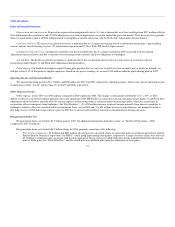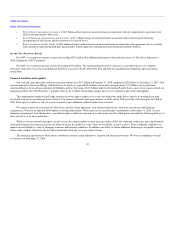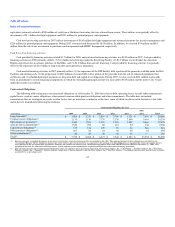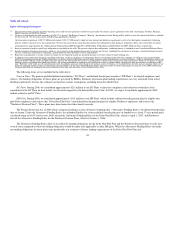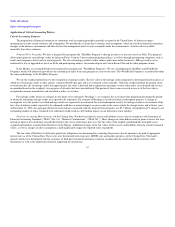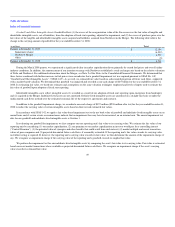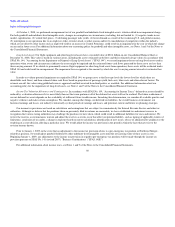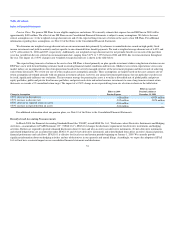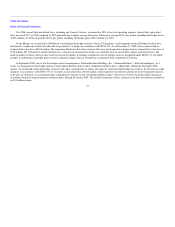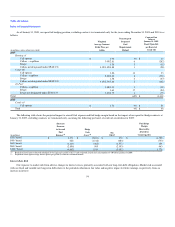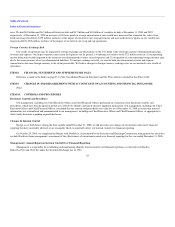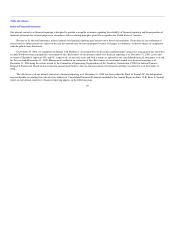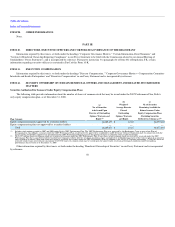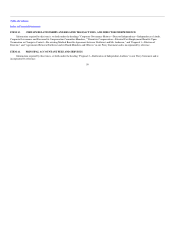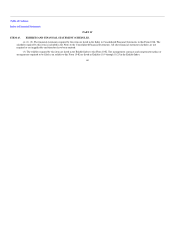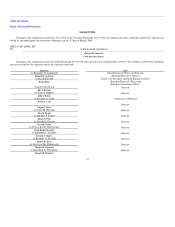Delta Airlines 2008 Annual Report Download - page 56
Download and view the complete annual report
Please find page 56 of the 2008 Delta Airlines annual report below. You can navigate through the pages in the report by either clicking on the pages listed below, or by using the keyword search tool below to find specific information within the annual report.
Table of Contents
Index to Financial Statements
Pension Plans. We sponsor DB Plans for our eligible employees and retirees. We currently estimate that expense for our DB Plans in 2009 will be
approximately $420 million. The effect of our DB Plans on our Consolidated Financial Statements is subject to many assumptions. We believe the most
critical assumptions are (1) the weighted average discount rate and (2) the expected long-term rate of return on the assets of our DB Plans. For additional
information regarding these assumptions, see Note 10 of the Notes to the Consolidated Financial Statements.
We determine our weighted average discount rate on our measurement date primarily by reference to annualized rates earned on high quality fixed
income investments and yield-to-maturity analysis specific to our estimated future benefit payments. We used a weighted average discount rate of 6.49% and
6.37% at December 31, 2008 and 2007, respectively. Additionally, our weighted average discount rate for net periodic benefit cost in each of the past three
years has varied from the rate selected on our measurement date, ranging from 5.67% to 7.19% between 2006 and 2008, due to remeasurements throughout
the year. The impact of a 0.50% change in our weighted average discount rate is shown in the table below.
The expected long-term rate of return on the assets of our DB Plans is based primarily on plan specific investment studies using historical returns on our
DB Plans' assets with forward looking estimates based on existing financial market conditions and forecasts. Modest excess return expectations versus some
market indices are incorporated into the return projections based on the actively managed structure of the investment programs and their records of achieving
such returns historically. We review our rate of return on plan asset assumptions annually. These assumptions are largely based on the asset category rate-of-
return assumptions developed annually with our pension investment advisors, however, our annual investment performance for one particular year does not,
by itself, significantly influence our evaluation. The investment strategy for pension plan assets is to utilize a diversified mix of global public and private
equity portfolios, public and private fixed income portfolios, and private real estate and natural resource investments to earn a long-term investment return
that meets or exceeds a 9% annualized return target. The impact of a 0.50% change in our expected long-term rate of return is shown in the table below.
Change in Assumption
Effect on 2009
Pension Expense
Effect on Accrued
Pension Liability at
December 31, 2008
0.50% decrease in discount rate +$8 million +$929 million
0.50% increase in discount rate -$12 million -$878 million
0.50% decrease in expected return on assets +$34 million —
0.50% increase in expected return on assets -$34 million —
For additional information about our pension plans, see Note 10 of the Notes to the Consolidated Financial Statements.
Recently Issued Accounting Pronouncements
In March 2008, the Financial Accounting Standards Board (the "FASB") issued SFAS No. 161, "Disclosures about Derivative Instruments and Hedging
Activities—an amendment to FASB Statement 133" ("SFAS 161"). SFAS 161 changes the disclosure requirements for derivative instruments and hedging
activities. Entities are required to provide enhanced disclosures about (1) how and why an entity uses derivative instruments, (2) how derivative instruments
and related hedged items are accounted for under SFAS 133, and (3) how derivative instruments and related hedged items affect an entity's financial position,
financial performance and cash flows. SFAS 161 is effective for fiscal years and interim periods beginning on January 1, 2009. We currently provide
significant information about our hedging activities and use of derivatives in our quarterly and annual filings. Accordingly, we expect the adoption of SFAS
161 will not have a material impact on our consolidated financial statements and disclosures.
51


